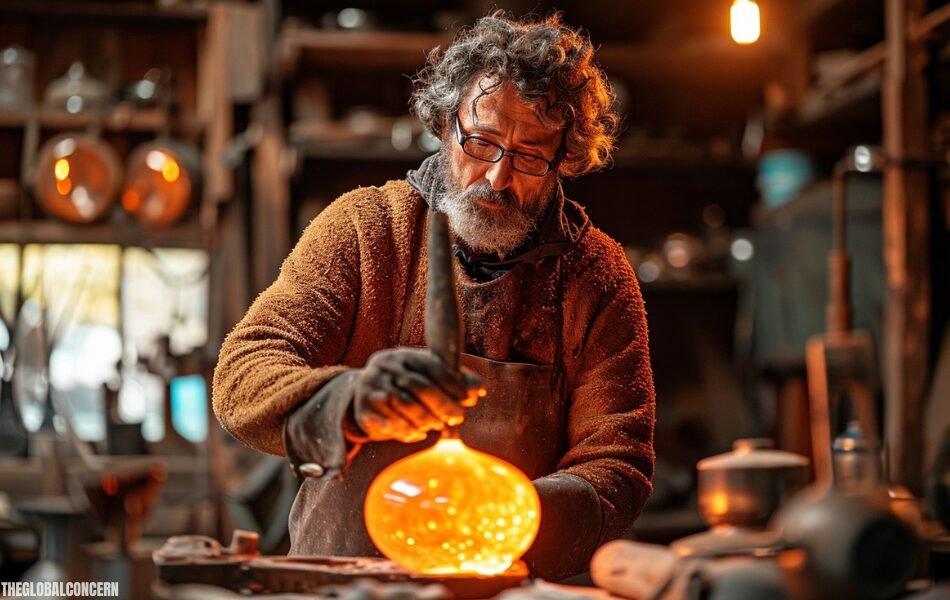Enchanting Handgeblasen Glass: A Timeless Art

Imagine a molten mass, glowing with an ethereal light, being coaxed and shaped by a skilled artisan’s breath. This is the magic of handgeblasen glass, a testament to human ingenuity and artistry. Handgeblasen, a German term meaning “hand-blown,” refers to glass objects crafted through the ancient technique of glassblowing.
This timeless art form has captivated cultures for centuries, producing exquisite pieces that range from functional to purely decorative. Each handgeblasen piece is a unique creation, imbued with the artisan’s skill and the unpredictable nature of the molten glass.
But what makes handgeblasen glass so special? How does it differ from machine-made glass? And why should you consider adding these stunning pieces to your home? In the following sections, we’ll delve into the fascinating world of handgeblasen glass, exploring its history, techniques, and enduring appeal.
The Timeless Art of Hand Blowing Glass
Handblown glass is a testament to centuries of human ingenuity and artistic expression. This ancient technique involves shaping molten glass into desired forms using tools and breath. The process is both delicate and demanding, requiring immense skill and precision.
The journey of a handblown glass piece begins with heating a gob of molten glass, often referred to as a gather, in a furnace. The glassblower then shapes the molten glass by blowing air into it through a hollow tube, known as a blowpipe. By manipulating the glass with tools and controlling the air pressure, the artisan can create a variety of shapes, from simple spheres to intricate vases and sculptures.
The origins of glassblowing can be traced back to ancient Rome, where it revolutionized the production of glass objects. Over centuries, the technique spread across the globe, evolving and adapting to different cultural and artistic influences. Today, handblown glass remains a highly valued art form, with artisans pushing the boundaries of creativity and innovation.
In recent years, glassblowers have embraced new techniques and technologies to expand the possibilities of their craft. For instance, the use of colored glass rods, known as canes, allows for intricate patterns and designs to be incorporated into the glass. Additionally, the development of specialized tools and equipment has enabled glassblowers to create more complex and delicate pieces.
Global Hotspots of Handgeblasen Glass
Certain regions around the world have earned global recognition for their exceptional handblown glass. These areas have a rich history of glassmaking, and their artisans continue to produce stunning works of art.
Often hailed as the birthplace of modern glassmaking, Murano has been a center of glass production for centuries. Venetian glassblowers have perfected intricate techniques, such as millefiori and avventurina, which involve incorporating colorful glass rods into the molten glass. Murano glass is renowned for its vibrant colors, intricate patterns, and elegant forms.
The Czech Republic has a long tradition of glassmaking, with Bohemia and Moravia being particularly famous for their high-quality crystal and glass. Czech glassblowers are skilled in producing a wide range of products, from delicate glassware to ornate chandeliers. The region’s glass industry is characterized by its innovative techniques and attention to detail.
The United States has a thriving glassblowing community, with numerous renowned glass artists and studios. The Pilchuck Glass School in Washington State is a world-renowned center for glass education and experimentation. American glassblowers are known for their diverse styles, ranging from traditional to contemporary.
The Unique Allure of Handgeblasen Glass
Handgeblasen glass possesses a distinct charm that sets it apart from machine-made glass. Each piece is a unique creation, bearing the mark of the artisan’s skill and the unpredictable nature of the molten glass.
One of the most striking characteristics of handblown glass is its inherent imperfection. Unlike machine-made glass, which is often perfectly symmetrical and uniform, handblown glass may exhibit slight variations in shape, size, and thickness. These imperfections, far from being flaws, add to the beauty and authenticity of the piece. They are a testament to the handmade nature of the object, reflecting the artistry and craftsmanship involved in its creation.
The color palette of handblown glass is incredibly diverse, ranging from soft pastels to vibrant hues. Glassblowers can achieve a wide range of colors by adding metallic oxides to the molten glass. Additionally, techniques like layering and marvering allow for the creation of intricate patterns and textures. The interplay of light and color in handblown glass can be truly mesmerizing.
Nurturing Your Handgeblasen Treasures
To ensure the longevity and beauty of your handgeblasen glass collection, proper care and maintenance are essential.
When cleaning your handblown glass pieces, it’s crucial to use gentle methods to avoid damaging the delicate surface. A soft, non-abrasive cloth dampened with warm, soapy water is ideal. Avoid using harsh detergents, scouring pads, or abrasive cloths, as these can scratch the glass. After cleaning, dry the pieces thoroughly with a lint-free cloth to prevent water spots.
Proper storage is key to preserving the condition of your handblown glass. Store your pieces in a cool, dry place, away from direct sunlight and extreme temperature fluctuations. Wrap each piece individually in soft tissue paper or bubble wrap to protect it from scratches and breakage. Consider using padded boxes or storage containers to further safeguard your collection.
While handblown glass is durable, accidents can happen. If your prized possession suffers a chip or crack, it’s best to consult a professional glass repair specialist. Attempting to repair the glass yourself may lead to further damage. A skilled artisan can often repair minor damage, such as chips or small cracks, using techniques like heat welding or adhesive bonding. However, severe damage may be irreparable.
Elevating Your Home with Handgeblasen Glass
Handgeblasen glass can add a touch of elegance and sophistication to any home decor style. Its versatility allows it to seamlessly blend with various interior aesthetics, from classic to contemporary.
One of the most captivating ways to incorporate handblown glass into your home is through lighting fixtures. A stunning handblown glass chandelier can be the focal point of a dining room or living room, casting a warm and inviting glow. Table lamps and pendant lights made from handblown glass can add a touch of artistry to bedrooms and home offices.
Handblown glass tableware is not only beautiful but also functional. From delicate wine glasses to elegant vases, these pieces can elevate your dining experience. A set of handblown glass bowls or platters can add a touch of luxury to your table setting.
Handblown glass can also be used to create stunning decorative accents. A unique handblown glass sculpture can be a conversation starter, while a collection of colorful glass vases can add a vibrant touch to any room.
By incorporating handblown glass into your home decor, you can create a truly unique and personalized space that reflects your individual style.
The Timeless Investment: Handgeblasen Glass
Handgeblasen glass, with its intricate craftsmanship and artistic beauty, has the potential to be a valuable investment. Several factors influence the value of these exquisite pieces: the skill and reputation of the glassblower, the rarity and age of the piece, its condition, design and aesthetic appeal, and its provenance.
If you’re considering investing in handgeblasen glass, it’s important to do your research, buy from reputable sources, consider future appreciation, diversify your collection, and store your pieces in a safe, climate-controlled environment.
Authenticity is paramount when investing in handgeblasen glass. Look for hallmarks, signatures, or labels that indicate the origin and maker of the piece. If you’re unsure about the authenticity of a piece, consult a reputable appraiser or expert. Appraisals can help you determine the fair market value of your collection, considering factors such as age, condition, artist, and rarity.
A Timeless Art Form
Handgeblasen glass is a testament to the enduring allure of human craftsmanship. From its ancient origins to contemporary innovations, this art form continues to captivate and inspire. Each handblown piece is a unique creation, imbued with the artist’s skill and the unpredictable nature of the molten glass.
As we’ve explored, handgeblasen glass offers a harmonious blend of beauty and functionality. Whether it’s a stunning chandelier illuminating a room or a delicate vase adorning a tabletop, these pieces elevate the spaces they inhabit. By understanding the intricacies of the glassblowing process, the cultural significance of various regions, and the proper care of these delicate objects, we can truly appreciate the artistry and value of handgeblasen glass.
We invite you to delve deeper into the world of handgeblasen glass. Share your experiences, ask questions, and continue to explore the endless possibilities of this captivating art form. Together, let’s celebrate the beauty and craftsmanship of handblown glass.
FAQs
Q: What is handgeblasen glass?
A: Handgeblasen is a German term meaning “hand-blown.” It refers to glass objects crafted through the ancient technique of glassblowing. This process involves shaping molten glass into desired forms using tools and breath.
Q: How is handblown glass different from machine-made glass?
A: Handblown glass is unique in its imperfections and individuality. Unlike machine-made glass, which is often perfectly symmetrical and uniform, handblown glass may exhibit slight variations in shape, size, and thickness. These imperfections add to the charm and authenticity of the piece.
Q: What are some famous regions for handblown glass?
A: Several regions are renowned for their exceptional handblown glass. Murano, Italy, is often considered the birthplace of modern glassmaking. The Czech Republic, particularly Bohemia and Moravia, is known for its high-quality crystal and glass. The United States, with its thriving glassblowing community, also produces stunning handblown glass.
Q: How can I care for my handblown glass pieces?
A: To care for your handblown glass, use gentle cleaning methods with warm, soapy water and a soft, non-abrasive cloth. Avoid harsh detergents and abrasive materials. Store your pieces in a cool, dry place, away from direct sunlight and extreme temperature fluctuations. Wrap them individually in soft tissue paper or bubble wrap for added protection.





